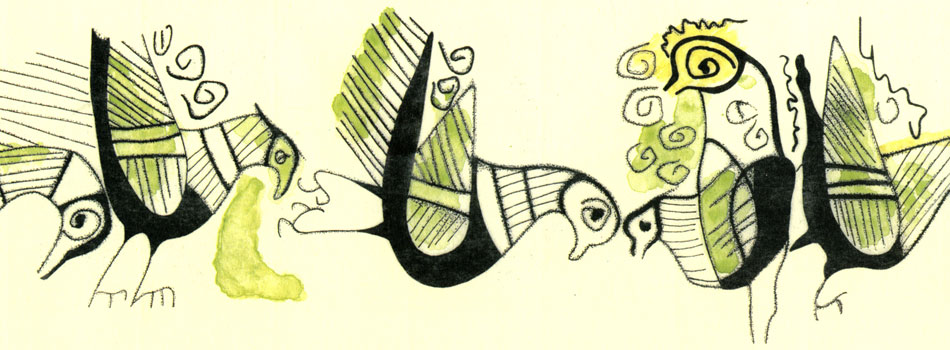VIIème Congrès International de l’AIECM2, Tessaloniki, 1999
Référence des Actes :
VIIe Congrès International sur la céramique médiévale en Méditerranée. Charalambos BAKIRTZIS Ed. Tessaloniki, 11-16 octobre 1999. Athènes, Ed. de la Caisse des Recettes Archéologiques, 2003, 777 p.
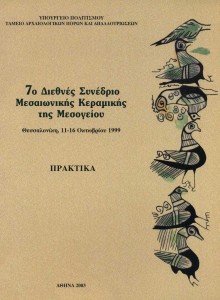 |
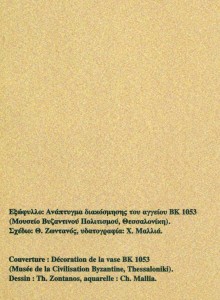 |
 |
 |
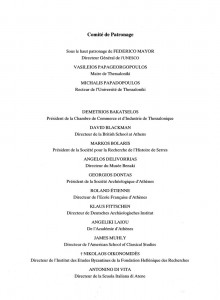 |
 |
 |
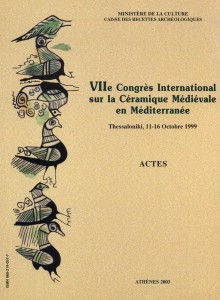 |
« Ouvrage épuisé, les Actes sont en ligne. »
SOMMAIRE
ΠΡΟΛΟΓΟΣ / Préface
Professeur Evangelos VENEZELOS — ΠΡΟΛΟΓΟΣ / Préface 15-17
Χαράλαμπος ΜΠΑΚΙΡΤΖΗΣ — ΠΡΟΛΟΓΟΣ / Préface 19-22
ΠΕΡΙΕΧΟΜΕΝΑ / Table des matières 23-26
1. ΑΝΑΜΕΣΑ ΣΕ ΑΝΑΤΟΛΗ ΚΑΙ ΔΥΣΗ. Η ΒΥΖΑΝΤΙΝΗ ΚΕΡΑΜΙΚΗ ΑΠΟ ΤΟ 10ο ΕΩΣ ΤΟΝ 15ο ΑΙΩΝΑ
Entre Orient et Occident La Céramique Byzantine, Xe-XVe Siècles 27
Χαράλαμπος ΜΠΑΚΙΡΤΖΗΣ — Η βυζαντινή κεραμική ανάμεσα σε Ανατολή και Δύση: Παρελθόν, παρόν και μέλλον 29-34
Guy D.R. SANDERS — An Overview of the new Chronology for 9th to 13th Century Pottery at Corinth 35-44
Δήμητρα ΠΑΠΑΝΙΚΟΛΑ – ΜΠΑΚΙΡΤΖΗ — Εργαστήρια εφυαλωμένης κεραμικής στο βυζαντινό κόσμο 45-66
Nergis GÜNSENIN — Au Moyen-Âge, un centre de production en Propontide dominant aussi le Bassin Méditerranéen : le cas de Ganos 67-70
Ιωάννης ΚΑΝΟΝΙΔΗΣ — Μεσοβυζαντινή Εφυαλωμένη Κεραμική με λευκό πηλό από ανασκαφές οικοπέδων στη Θεσσαλονίκη 71-76
Alexander KUZEV — Byzantinische Keramik (11.-12. Jh.) aus der Dobrudscha 77-80
Stella PATITICCI UGGERI — « Zeuxippus Ware »: Novità da Kyme Eolica (Turchia) 81-90
Arthur H.S. MEGAW, Pamela ARMSTRONG, Helen HATCHER — Zeuxippus Ware: An Analytical Approach to the Question of Provenance 91-100
Alla ROMANČUK — Befunde der glasierten Keramik der spätbyzantinischen Zeit in Chersonesos: örtliche Herstellung und Import 101-114
Δημήτριος ΜΙΧΑΗΛΙΔΗΣ, Χαράλαμπος ΜΠΑΚΙΡΤΖΗΣ — «Αραβικοί» αμφορείς στην Κύπρο 125-136
Vesna BIKIĆ — Byzntine Models of Serbian Medieval Pottery 191-204
Henry MAGUIRE — The Feasting Cycle and the Meanings of Hybrids in Byzantine Ceramics 205-210
Ναταλία ΠΟΥΛΟΥ – ΠΑΠΑΔΗΜΗΤΡΙΟΥ — Μεσοβυζαντινή κεραμική από την Κρήτη: 9ος – 12ος αιώνας 211-226
Afrim HOTI — Some Features of the early Medieval Pottery in Albania (7th-l1th Centuries) 237-240
Aikaterini TSANANA — The glazed Pottery of Byzantine Vrya (Vrea) 245-250
Anastasios P. BOZOLOUPOS — Glazed Pottery of Thessaloniki: An archaeometrical Approach 259-260
2. ΜΕΘΟΔΟΙ ΠΑΡΑΓΩΓΗΣ ΚΑΙ ΤΡΟΠΟΙ ΔΙΑΚΙΝΗΣΗΣ ΤΗΣ MEΣΑΙΩΝΙΚΗΣ ΚΕΡΑΜΙΚΗΣ ΣΤΗ ΜΕΣΟΓΕΙΟ
Modes de production et modes de diffusion sur la longue durée 261
Juan ZOZAYA, Alfredo APARICIO YAGÜE — Análisis de cerámicas andalusíes 341-350
Paolo GÜLL — Roma nel rinascimento: un caso di autoconsumo? 421-426
Yves PORTER — Les techniques du lustre métallique d’après le JOWHAR-NÂME-YE NEZÂMI (1196 AD) 427-436
Platon PETRIDIS — Ateliers de potiers protobyzantins à Delphes 443-446
Nikos ZEKOS — A Glazed Pottery Workshop in Thrace 455-466
3. ΑΠΟ ΤΗ ΡΩΜΗ ΣΤΟ ΒΥΖΑΝΤΙΟ, ΑΠΟ ΤΟ ΦΟΣΤΑΤ ΣΤΗΝ ΚΟΡΔΟΒΑ, 5ος – 9ος ΑΙΩΝΑΣ
De Rome à Byzance ; de Fostat à Cordoue : Ve-IXe Siècles 467
Stella DEMESTICHA Amphora Production on Cyprus during the Late Roman Period 469-476
Giovanni DI STEFANO — Ceramiche da cucina dal Chorion di Kaukana in Sicilia 505-508
Ευγενία ΓΕΡΟΥΣΗ — «Αιγαιακό» εργαστήριο παραγωγής λυχναριών του 6ου αιώνα 513-516
Vera ZALESSKAYA — Les eulogies céramiques dans le monde byzantin (Ve-XIe siècles) 517-518
ΣΥΖΗΤΗΣΗ – ΣΤΡΟΓΓΥΛΗ ΤΡΑΠΕΖΑ ΑΠΟ ΤΗ ΡΩΜΗ ΣΤΟ ΒΥΖΑΝΤΙΟ, ΑΠΟ ΤΟ ΦΟΣΤΑΤ ΣΤΗΝ ΚΟΡΔΟΒΑ: ΕΞΕΛΙΞΗ ΤΗΣ ΦΥΣΙΟΓΝΩΜΙΣ ΤΩΝ ΚΕΡΑΜΙΚΩΝ ΣΤΗ ΜΕΣΟΓΕΙΟ (5ος – 9ος ΑΙΩΝΑΣ)
Discussion – Table ronde. De Rome à Byzance ; de Fostat à Cordoue : évolution des faciès céramiques en Méditerranée (Ve-IXe siècles) 523
Gabrielle DÉMIANS d’ARCHIMBAUD, Jean-Pierre SODINI, John HAYES, Platon PETRIDIS, Paul REYNOLDS, Alexandra USCATESCU, Roland-Pierre GAYRAUD, Michel BONIFAY, Adnan LOUHICHI, Lucy VALLAURI, Lidia PAROLI (Επιμέλεια – Edition: Michel BONIFAY) 525-594
4. Η ΒΟΡΕΙΟΣ ΑΦΡΙΚΗ, Η ΑΝΑΤΟΛΗ ΚΑΙ Η ΔΥΣΗ
Maghreb, Machrek et Occident 595
Aicha HANIF — Tamoukhakht, ancien centre de production céramique dans le Sud marocain 633-638
Susana GÓMEZ MARTÍNEZ — Producciones cerámicas en la Mértola islámica 653-658
Ana GOMES — Cerâmica pintada a branco de Lisboa 659-668
Adnan LOUHICHI — La céramique de l’Ifriqiya du IXe au Xle siècle d’après une collection inédite de Sousse 669-682
Ma del Camino FUERTES SANTOS, Juan F. MURILLO REDONDO, Ma Dolores LUNA OSUNA — Aproximación a la evolución de la cerámica medieval cordobesa 683-684
Abdallah FILI, Ronald MESSIER — La céramique médiévale de Sijilmasa 689-690
Jacinta BUGALHÃO, Deolinda FOLGADO — Islamic Pottery Production in the Outskirts of Lisbon 691-696
Teresa Júdice GAMITO — Ukxûnuba (Faro, Portugal). An islamic City on the Lagoon 697-700
5. ΝΕΩΤΕΡΑ ΕΥΡΗΜΑΤΑ
Dernières découvertes 701
Λιάνα ΣΤΑΡΙΔΑ — Μεσοβυζαντινή εφυαλωμένη κεραμική από το Ηράκλειο 713-724
Manuela ALMEIDA TERREIRA — Trouvailles céramiques du Terreiro de Erva (Coimbra – Portugal) 759-762
Παρή ΚΑΛΑΜΑΡΑ — Η βυζαντινή κεραμική της Μονεμβασίας και η τοπική παραγωγή 769-772
Voir aussi les publications des expositions accompagnant le congrès
Publications des expositions accompagnant le VIIe Congrès sur la Céramique Médiévale en Méditerranée, Thessalonique, 1999
Papanikola-Bakirtzi (D.), Mavrikiou (F.N.), Bakirtzis (C.).— Byzantine Glazed Pottery in the Benaki Museum, Benaki Museum, Athens 1999, 204 p.
On the occasion of the 7th International Congress on Medieval Ceramics in the Mediterranean (Thessaloniki, 11-16 October 1999), the Benaki Museum in Athens organized a temporary exhibition of its collection of Byzantine glazed pottery and published the catalogue of the exhibition in Greek and English. The collection was started by the founder of the museum, Andonis Benakis, and but it was augmented and systematised by the museum’s first director , Theodoros Makridis (1931-40).
The introduction to the catalogue describes how the collection was put together and underlines the importance of the collection, the core of which is made up of wares from Constantinople and talks about the interest which Byzantine glazed pottery aroused among scholars and collectors in the first hald of the twentieth century. This is followed by the catalogue proper, 357 items in white or red clay, divided according to their decorative technique into groups: Painted Ware (Polychrome tiles and vases, Green and Brown Painted Ware, Brown Painted Ware, Blue Painted Ware); Incesed Ware; Relief Ware/Slip-painted Ware; Sgraffito Ware (Fine Sgraffito Ware, Painted Fine Sgraffito Ware, Incised Sgraffito Ware, Champleve Ware, Zeuxippus Ware); Palaeologan Ware (Plain Sgraffito Ware, Green Sgraffito Ware, Brown and Green Sgraffito Ware, Cypriot Sgraffito Ware); Plain Glazed Palaeologan Ware. Each group is preceded by an introduction giving technical characteristics, datings, and comments on the ceramics in that group. All the pottery in the catalogue is illustrated by black-and-white photographs, and the most important pieces are accompanied by colour photographs and by drawings of the decoration and sections. An abbreviated bibliography accompanies the footnotes.
The book is distributed by Benaki Museum, Koubari 1, Kolonaki Athens, Tel n° 00 30 1 36 11 617, fax 00 30 1 36 22 547
Papanikola-Bakirtzi (D.) ed.— Byzantine Glazed Ceramics. The Art of Sgraffito. Published by the Archaeological Receips Fund. Athens, 1999.
On the occasion of the 7th International Congress on Medieval Ceramics in the Mediterranean which was held in October 1999 in Thessaloniki, the Museum of Byzantine Culture organised an exhibition entitled Byzantine Glazed Ceramics. The Art of Sgraffito, which was accompanied by a catalogue in greek and english. The 270 pages present 307 vases from all over Greece, from the Peloponnese to Crete and Thrace each with a detaided commentary and fully illustrated with colour photographs and profiles.
The catalogue is divided into three parts. The first is devoted to the history and evolution of engraved decoration from the Middle Byzantine to the Post-Byzantine period (11th-17th cent.).
The second part comprises finds from the wrecks of two Byzantine ships, whose cargoes consisted mainly of glazed tableware with engraved decoration. The first of these sank about the middle of the 12th century off Pelagonnisi in the Northern Sporades, and the second in the early 13th century off Kastellorizo in the Dodecanese;
The third part contains groups of wares with shared features that may be attributed to specific production centres in Greece. There are also a significant number of finds associated with the pottery manufacturing process, such as remains of kiln equipment and deformed, burned or unfinished wares.
Byzantine Glazed Ceramics. The Art of Sgraffito aspires, through the 300-plus representative items which it presents and the introductory texts written by Demetra Papanikola-Bakirtzis, Aikaterini P. Dellaportas, Guy D. R. Sanders, Nikolaos Zikos, Georgia Papazotos, to make a contribution to the study of Byzantine pottery.
The book is distributed by Eleftheroudakis Bookstores, 17 Panepistimiou str., Athens. tel. 00 30 1 33 14 180, fax 00 30 1 32 39 821

